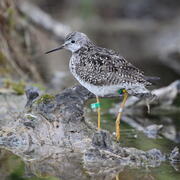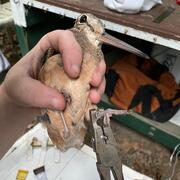Reports of banded birds that have collided with windows are not uncommon for the U.S. Geological Survey’s Bird Banding Lab, with up to two billion birds are killed each year in the United States due to collisions with glass. Learn more below about the threat of bird collisions, current science and future opportunities.
Up to two billion birds are killed each year in the United States due to collisions with glass, and many birds can die during mass collision events in urban areas, one of which recently occurred in Chicago when 1,000 birds struck one building, over one night. However, single collision events can occur any time of the year at our homes, schools, or offices as well and have a cumulative impact across the landscape.
Birds often fail to see glass as an obstacle and collide with windows when they fly towards natural reflections of habitat, like sky or plants. Birds are also attracted to lights shining through windows or from nearby porches and yards. Although some birds may seem unharmed after a collision with glass, many may die later from head trauma or other injuries.
While some collided birds are banded, many are not. Any banded bird that collides with glass provides a small glimpse at the serious problem of window collisions, as well as vital information for that bird such as seasonal and temporal patterns, migratory pathways, and the reason for a bird’s demise. To report a band to the USGS Bird Banding Laboratory from a bird that has collided with glass, please submit at reportband.gov. Be sure to indicate that the bird struck a building or window in the “How Obtained” data field.
There are simple, inexpensive, and attractive ways to help prevent any type of bird collision by making windows more visible to birds. To be effective, window patterns should be spaced in a 2-inch by 2-inch grid pattern and be placed on the outside of windows. For low-cost, temporary methods, individuals can make and hang a paracord bird curtain or create decorative patterns using tempera paint and stencils. For more long-term solutions, individuals can consider using dense decal markers (such as dots), external, or “fritted” glass that includes exterior patterns to make the glass visible to birds). For more information on solutions, see here.
The U.S. Geological Survey is currently exploring how we may add to the science of understanding bird collisions through the data collected from the Bird Banding’s Lab database.
Learn More:
-
USGS Joins the Bird Collision Prevention Alliance to Combat Bird Collisions USGS Joins the Bird Collision Prevention Alliance to Combat Bird Collisions
USGS has joined a new initiative to address bird collisions with glass.
-
USGS EESC walks the walk for bird collisions USGS EESC walks the walk for bird collisions
In July 2024, the U.S. Geological Survey’s (USGS) Eastern Ecological Science Center (EESC) at Patuxent Research Refuge wrapped up a project to replace the perforated vinyl film on the windows of the Gabrielson building and replace it with a more aesthetically pleasing, yet protective, bird collision deterrent “dots.”
-
Surviving Migration Through an Urban Landscape! One Songbird’s Journey Surviving Migration Through an Urban Landscape! One Songbird’s Journey
Spring migration has officially begun and now is the time to make sure your windows are safer for birds!
-
On a golden wing and a prayer: your actions can give birds a better chance of surviving migration On a golden wing and a prayer: your actions can give birds a better chance of surviving migration
Although we may feel worlds apart, we are connected by migratory birds. In turn, migratory birds are connected to us and directly affected by our actions.
-
A Surprising Band Recovery from the USGS Bird Banding Lab’s Fall Migration Station A Surprising Band Recovery from the USGS Bird Banding Lab’s Fall Migration Station
The Bird Banding Lab recently got a report of an amazing banding recovery! A Cape May warbler that was banded at the lab’s fall migration station in 2013 was found this September in Pennsylvania, shattering the longevity record at a remarkable 9 years old! Unfortunately, this warbler will not be able to continue her journey south as she was found dead after striking a window.
-
-
Bird Collisions: Current Science and Future Opportunities
The USGS Eastern Ecological Science Center Bird Banding Lab webinar on the threat of bird collisions, current science and future opportunities. It is estimated that over 1 billion birds are killed annually by collisions with glass every year in the United States. This webinar will provide an overview on the threat of bird collisions, the state of the science, how the USFWS is taking the lead to...
-
-
EESC in the News: Road to Recovery for North American Birds EESC in the News: Road to Recovery for North American Birds
By Gustave Axelson, Photos by Sparky Stensaas Living Bird Magazine, Winter 2025 After a 2019 study identified major losses to North American bird populations, scientists are working to reverse the declines through pilot projects with Evening Grosbeaks, Lesser Yellowlegs, and others.
-
EESC in the News: One Bird Too Many EESC in the News: One Bird Too Many
By Mason Wheatley USFWS, November 2024 In the cold of February, a bird was found dead on the sidewalk of Philadelphia, killed after colliding with a building window. It was an American woodcock, or timberdoodle – an iconic gamebird of eastern North America, adored by nature lovers and hunters alike.
Reports of banded birds that have collided with windows are not uncommon for the U.S. Geological Survey’s Bird Banding Lab, with up to two billion birds are killed each year in the United States due to collisions with glass. Learn more below about the threat of bird collisions, current science and future opportunities.
Up to two billion birds are killed each year in the United States due to collisions with glass, and many birds can die during mass collision events in urban areas, one of which recently occurred in Chicago when 1,000 birds struck one building, over one night. However, single collision events can occur any time of the year at our homes, schools, or offices as well and have a cumulative impact across the landscape.
Birds often fail to see glass as an obstacle and collide with windows when they fly towards natural reflections of habitat, like sky or plants. Birds are also attracted to lights shining through windows or from nearby porches and yards. Although some birds may seem unharmed after a collision with glass, many may die later from head trauma or other injuries.
While some collided birds are banded, many are not. Any banded bird that collides with glass provides a small glimpse at the serious problem of window collisions, as well as vital information for that bird such as seasonal and temporal patterns, migratory pathways, and the reason for a bird’s demise. To report a band to the USGS Bird Banding Laboratory from a bird that has collided with glass, please submit at reportband.gov. Be sure to indicate that the bird struck a building or window in the “How Obtained” data field.
There are simple, inexpensive, and attractive ways to help prevent any type of bird collision by making windows more visible to birds. To be effective, window patterns should be spaced in a 2-inch by 2-inch grid pattern and be placed on the outside of windows. For low-cost, temporary methods, individuals can make and hang a paracord bird curtain or create decorative patterns using tempera paint and stencils. For more long-term solutions, individuals can consider using dense decal markers (such as dots), external, or “fritted” glass that includes exterior patterns to make the glass visible to birds). For more information on solutions, see here.
The U.S. Geological Survey is currently exploring how we may add to the science of understanding bird collisions through the data collected from the Bird Banding’s Lab database.
Learn More:
-
USGS Joins the Bird Collision Prevention Alliance to Combat Bird Collisions USGS Joins the Bird Collision Prevention Alliance to Combat Bird Collisions
USGS has joined a new initiative to address bird collisions with glass.
-
USGS EESC walks the walk for bird collisions USGS EESC walks the walk for bird collisions
In July 2024, the U.S. Geological Survey’s (USGS) Eastern Ecological Science Center (EESC) at Patuxent Research Refuge wrapped up a project to replace the perforated vinyl film on the windows of the Gabrielson building and replace it with a more aesthetically pleasing, yet protective, bird collision deterrent “dots.”
-
Surviving Migration Through an Urban Landscape! One Songbird’s Journey Surviving Migration Through an Urban Landscape! One Songbird’s Journey
Spring migration has officially begun and now is the time to make sure your windows are safer for birds!
-
On a golden wing and a prayer: your actions can give birds a better chance of surviving migration On a golden wing and a prayer: your actions can give birds a better chance of surviving migration
Although we may feel worlds apart, we are connected by migratory birds. In turn, migratory birds are connected to us and directly affected by our actions.
-
A Surprising Band Recovery from the USGS Bird Banding Lab’s Fall Migration Station A Surprising Band Recovery from the USGS Bird Banding Lab’s Fall Migration Station
The Bird Banding Lab recently got a report of an amazing banding recovery! A Cape May warbler that was banded at the lab’s fall migration station in 2013 was found this September in Pennsylvania, shattering the longevity record at a remarkable 9 years old! Unfortunately, this warbler will not be able to continue her journey south as she was found dead after striking a window.
-
-
Bird Collisions: Current Science and Future Opportunities
The USGS Eastern Ecological Science Center Bird Banding Lab webinar on the threat of bird collisions, current science and future opportunities. It is estimated that over 1 billion birds are killed annually by collisions with glass every year in the United States. This webinar will provide an overview on the threat of bird collisions, the state of the science, how the USFWS is taking the lead to...
-
-
EESC in the News: Road to Recovery for North American Birds EESC in the News: Road to Recovery for North American Birds
By Gustave Axelson, Photos by Sparky Stensaas Living Bird Magazine, Winter 2025 After a 2019 study identified major losses to North American bird populations, scientists are working to reverse the declines through pilot projects with Evening Grosbeaks, Lesser Yellowlegs, and others.
-
EESC in the News: One Bird Too Many EESC in the News: One Bird Too Many
By Mason Wheatley USFWS, November 2024 In the cold of February, a bird was found dead on the sidewalk of Philadelphia, killed after colliding with a building window. It was an American woodcock, or timberdoodle – an iconic gamebird of eastern North America, adored by nature lovers and hunters alike.









